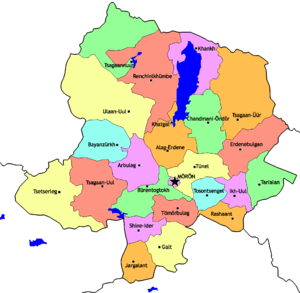User:Jordang1276/sandbox
 | This is a user sandbox of Jordang1276. You can use it for testing or practicing edits. This is not the sandbox where you should draft your assigned article for a dashboard.wikiedu.org course. To find the right sandbox for your assignment, visit your Dashboard course page and follow the Sandbox Draft link for your assigned article in the My Articles section. |

Dukhan Language
[edit]The Dukhan language belongs to the Sayan Turkic/Taiga subgroup (including the Tuvan and Tofa groups)[1]. The language is almost extinct and is currently only used as a secondary language. The proposal code ISO 639-3 was requested, but ultimately rejected.[2]
| Dukhan | |
|---|---|
| Region | Sum (district) |
| Number of Speakers | 500 |
| Country | Mongolia |
Origin
[edit]The Dukha language or Dukhan is a variety mix of an endangered Turkish language. It is spoken by about five hundred people of the Dukhan (also Tsaatan) from the Tsagaan-Nuur County, Tsagaannurr (Khovsgol) Mongolia. Цагааннуур сум) is a Sum (district) of Mongolia in the province of Khovsgol, located in Northern Mongolia.
Classification of Turkish Languages
[edit]| Proto-Turkish | Turkish | Siberia | Northern Siberia |
| |
| Southern Siberia | Southern Siberia | ||||
| Old Turkish |
| ||||
| Lower Chullym |
| ||||
| Altai Turkic[6] |
| ||||
Current Situation
[edit]Currently, The Dukhan language is mainly related to the amalgam of dialects from the nomadic people of Inner Mongolia, China, Russia, and surrounding areas.
- Buryat is a Mongolian language spoken in Russia, in the republic of Buryatia, and by smaller populations in Mongolia and China, in the East of Inner Mongolia. It is the language of the Buryats.
- The Tuvain (Or Tuvine Language, Tuvinian)[7] is a language of the family of Turkish languages spoken by nearly 200,000 Tuvans in the Republic of Tuva, Russia. Small groups speak Tuvain in Mongolia and China. The Tuvain contains many words borrowed from Mongolian and has been influenced by Russian over the last hundred years.
- Tofalar (or tofa, karagas) is a Turkish language spoken in the Ninjnewinsk region of the Irkutsk Oblast in Russia.
Bibliography
[edit]- Dolatkhah, Sohrab. 2016. Let's talk qashqay. In: "Let's talk" collection. Paris: The Harmattan.
- Dolatkhah, Sohrab. 2016. The qashqay: Turkic language of Iran. CreateSpace Independent Publishing Platform (online).
- Pierre-François Viguier, Elements of the Turkish language, or analytical tables of the usual Turkish language, with their development, dedicated to the King, under the auspices of M. The Comte de Choiseul-Gouffier, Ambassador of His Most Christian Majesty near the Ottoman Gate, by M. Viguier, Prefect Apostolic of the Establishments of the Congregation of the Mission in the Levant, Constantinople, from the Imprimerie du Palais de France, March 1790, in-4 °
Article Translated
[edit]http://fr.wiki.x.io/wiki/Dukhan_(langue)
{{Dukhan (langue) |fr|http://fr.wiki.x.io/wiki/Dukhan_(langue)}}
Noted References
[edit]- ^ Endangered Languages of Indigenous Peoples of Siberia: The Soyot Language
- ^ [1]
- ^ Deviating. Probably of South Siberian origin (Johanson 1998)
- ^ Coene 2009, p. 75
- ^ Coene 2009, p. 75
- ^ Some dialects are close to Kirghiz (Johanson 1998)
- ^ Roland Breton, Atlas des langues du monde, Éd. Autrement, 2003 ISBN 2-7467-0400-5
